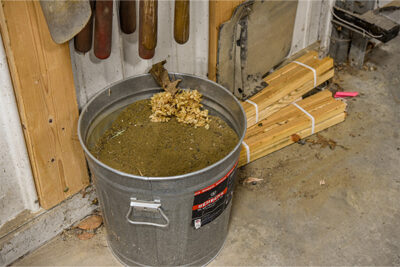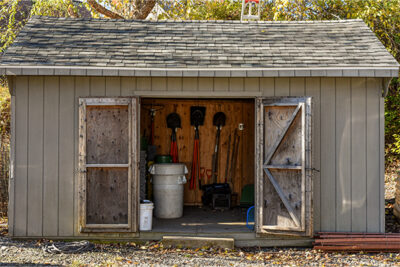By New England Botanic Garden staff
October 2024
During the gardening season, amidst watering, weeding, deadheading, and the plethora of other chores you took on to keep your spaces lush and beautiful, chances are gardening tool maintenance may have taken a back seat. That’s ok. With the season now winding down, there’s no better time to brush up on general maintenance tips and to show your trusty gardening tools some tender loving care.
Practice good tool hygiene
Just because our tools spend a lot of time in the dirt doesn’t mean they should stay dirty. Cleaning dirt and other debris from tools is one of those chores best done regularly and then once again thoroughly before putting tools away for the season. At the Garden, our horticulturists keep a galvanized metal bucket of sand on standby and use it to stick trowels, spades, and other tools into after a day of use. The sand easily pulls dirt and other biomaterials from the tools. Adding a little oil into the sand is another trick to help keep your tools well-oiled and works to scrape away rust on a regular basis.
Another element of regular tool cleaning and maintenance should be sanitizing. If your tools have been involved in removing diseased or infected branches from plants in your garden, plunging them into a sand bucket won’t be enough to eliminate dangerous bacteria that could spread to other plants when the tool is picked up and put to use again. You should sanitize your tools by applying isopropyl alcohol on the blades or any parts that met with the diseased plant before pruning others in your garden. Garden horticulturists even recommend sanitizing before moving between sections of the same plant. This is especially important if you have an orchard or other fruiting trees susceptible to fire blight and other bacterial diseases.
Sharpen up for spring
With bladed tools like pruners and loppers, edges dull with use and eventually need to be sharpened. You’ll thank yourself next season when you cross this task off your list now. Whetstones work for smaller tools, but some bigger bladed tools like hedge shears may require flat files for sharpening.
Let’s talk about tools we should not sharpen as well. Many modern pruning sawblades use a difficult to sharpen Japanese-style tooth pattern with impulse-hardened teeth. These teeth help the saw function for longer without needing to be sharpened, however when the time comes to sharpen, they are brittle and easy to break. The best option for bent, or excessively dull blades is replacement.
Oil at the end of the season
Because gardening tools get used regularly during spring and summer, they often do not have time to develop rust. This is different once the gardening season ends and tools get set aside for months at a time. Before storing your tools, take the time to prevent rust by oiling them properly. WD40 is often good enough, but you can also consider using tool oil from manufacturers like DeWit and Felco. If you’d like to avoid using petroleum-based oil, vegetable oil in a spray bottle works well for preventing surface rust and lubricating moving parts. It will just need to be applied more frequently than a petroleum-based product. Natural oils have a tendency to go rancid, so check your tools more frequently if going this route.
Don’t forget that the wooden handles of our tools work hard, too. If you have a tool with an unlacquered wooden handle, consider applying boiled linseed oil to prevent the wood from drying out and cracking. Wood absorbs oil best at room temperature and should be done in a warmer space. Make sure to follow all disposal information for rags used due to the risk of fire.
Properly store power tools
When it comes to electric or gas-powered tools, it’s essential to clean out dirt and rust build-up, sharpen bladed parts, and spray lubricant on metal parts such as chains before putting these tools away for winter. However, with gas-powered tools, it’s also important to take note of any unused fuel and oil. Because fuel degrades over time, it should not be left to sit in your tools over winter. One of the many benefits of transitioning to electric tools is not having to worry about the mess, expense, or dangers of fuel! That said, you should always check out the manufacturer’s directions for storing battery-powered tools over winter to make sure you’re following their guidance.
Finally, get organized
Autumn may be cozy season, but leaving your tools cozied up in a heap in your shed can make them deteriorate faster. No matter how you choose to organize your tools, make sure that the area you dedicate to storage is cool and dry. Outside of that, do what works best for you, so that, come spring, you and your tools are ready to make those new garden dreams a reality.


